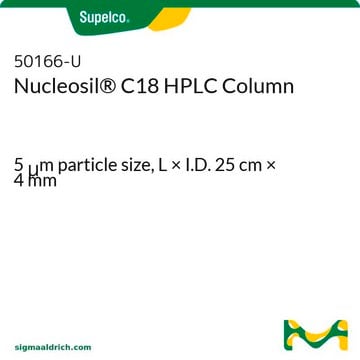The phenyl-hexyl phase is 100% aqueous compatible.
推薦產品
產品名稱
Ascentis® Express Phenyl-Hexyl,2.7μm HPLC色谱柱, 2.7 μm particle size, L × I.D. 15 cm × 4.6 mm
材料
stainless steel column
品質等級
agency
suitable for USP L11
產品線
Ascentis®
特點
endcapped
製造商/商標名
Ascentis®
包裝
1 ea of
參數
60 °C temp. range
600 bar max. pressure (9000 psi)
技術
HPLC: suitable
LC/MS: suitable
UHPLC-MS: suitable
UHPLC: suitable
長度 × 內徑
15 cm × 4.6 mm
表面積
135 m2/g
雜質
<5 ppm metals
基質
Fused-Core particle platform
superficially porous particle
基質活性組
phenylhexyl phase
粒徑
2.7 μm
孔徑
90 Å
pH值範圍
2-9
應用
food and beverages
分離技術
reversed phase
尋找類似的產品? 前往 產品比較指南
一般說明
應用
- 以HPLC-DAD-ESI IT-TOF-MSn表征氟班色林新降解产物的不同视角及其药物制剂分析的实验室间比较: 本研究利用Ascentis Express ®Phenyl Hexyl 2.7μm HPLC柱来表征氟班色林的降解产物,证明了其在高分辨率分析应用中的有效性® (Geven et al., 2023).
- 用于定量测定人血浆中超长链脂肪酸的带分光光度或质谱检测HPLC及其与心脏危险因素的关系: Ascentis ®Express Phenyl-Hexyl 柱被用于脂肪酸的精确测定,将其用途与心脏危险因素的关键临床研究联系起来 (Shrestha et al., 2021)。
- 一种使用直接进样结合熔融芯柱在线SPE-HPLC的全自动快速方法,用于测定拉格啤酒中的赭曲霉毒素A和桔霉素。: 这项研究重点关注了Ascentis ®Express Phenyl-Hexyl 柱在检测饮料中污染物方面的效率,强调了其在食品安全分析中的作用(Lhotska et al., 2016)。
- 采用融合核柱色谱法研究了含白藜芦醇和虎杖苷的营养保健品的保留特性和质量控制: 本研究探讨了使用Ascentis ®Express Phenyl-Hexyl柱的营养保健品的保留特性,展示了其在保健增补剂质量控制中的实用性(Fibigr et al., 2016)。
- 用于样品预浓缩和测定地表水中苯氧威和顺反式氯菊酯测定的在线SPE-HPLC法: Ascentis ®Express Phenyl-Hexyl 柱在预浓缩和分析环境样品中的农药残留方面是不可或缺的,突显了其环境分析应用(Satinsky et al., 2015)。
法律資訊
相關產品
防護柱套
儲存類別代碼
11 - Combustible Solids
水污染物質分類(WGK)
WGK 3
閃點(°F)
Not applicable
閃點(°C)
Not applicable
從最近期的版本中選擇一個:
分析證明 (COA)
客戶也查看了
文章
Improve your reversed phase selectivity for polar aromatics and heterocyclic compounds with the Ascentis® Express Phenyl-Hexyl U/HPLC column.
-
Can a 100% aqueous mobile phase be used with the Phenyl-Hexyl HPLC column?
1 answer-
Helpful?
-
-
Can I use Ascentis Express on any type of HPLC system?
1 answer-
Ascentis Express HPLC columns are capable of use on standard HPLC systems as well as UHPLC systems. Columns are packed in high pressure hardware capable of withstanding the pressures used in UHPLC systems.
Helpful?
-
-
Can I use Ascentis Express on a UHPLC system?
1 answer-
Yes. Ascentis Express columns are packed in a way making them suitable for these ultra high pressure instruments. In fact, Ascentis Express outperforms sub-2 μm micron columns on many applications since Ascentis Express provides the benefits of sub-2 μm particles but at much lower back pressure. These benefits include the capability of providing fast HPLC and higher resolution chromatography. The Fused-Core particle consists of a 1.7 μm solid core and a 0.5 μm porous shell. A major benefit of the Fused-Core particle is the small diffusion path (0.5 μm) compared to conventional fully porous particles. The shorter diffusion path reduces axial dispersion of solutes and minimizes peak broadening.
Helpful?
-
-
How can I measure my instrument bandwidth (IBW) and determine what Ascentis® Express HPLC Columns can be used with minimal efficiency loss created by too much internal instrument volume?
1 answer-
The Guide to Dispersion Measurement has simple instructions on how to measure IBW and can be found at sigma-aldrich.com/express.
Helpful?
-
-
What flow rate should I use with Ascentis® Express HPLC Columns?
1 answer-
Based on the minimum in the van Deemter curves, higher flows than 5um particle columns are required in order to maximize Ascentis Express column efficiency. The suggested starting point for flow rate for Ascentis Express columns: 1.6 mL/min for 4.6 mm ID; 0.8 mL/min for 3.0 mm ID; and 0.4mL/min for 2.1 mm ID.
Helpful?
-
-
Can Ascentis® Express HPLC Columns be used for LC-MS?
1 answer-
Express Fused-Core™ particles were designed with LC-MS in mind. Even extremely short column lengths exhibit sufficient plate counts to show high resolving power. The flat van Deemter plots permit resolution to be maintained at very high flow rates to maximize sample throughput. All Ascentis stationary phases have been evaluated for MS compatibility during their development, and the Express phases are no exception. You can expect extremely low column bleed and background while maintaining longest possible column lifetime. A bonus of Ascentis Express columns for high throughput UHPLC and LC-MS is that they are extremely rugged and highly resistant to plugging, a very common failure mode for competitor columns.
Helpful?
-
-
Is there anything special I need to do to my HPLC system to use Ascentis Express?
1 answer-
Nothing special is required to use Ascentis Express HPLC columns. To obtain the full benefits of Ascentis Express, one should minimize dispersion or instrument bandwidth in the HPLC system (tubing, detector flow cell) as well as confirm the detector response system is set at a fast level. For more information, request Guidelines for Optimizing Systems for Ascentis Express Columns (T407102)
Helpful?
-
-
What is the Department of Transportation shipping information for this product?
1 answer-
Transportation information can be found in Section 14 of the product's (M)SDS.To access the shipping information for this material, use the link on the product detail page for the product.
Helpful?
-
-
What is the pressure rating for Ascentis® Express Phenyl-Hexyl HPLC Columns?
1 answer-
This Ascentis Express column is stable to operating pressures up to 600 bar (9000 psi).
Helpful?
-
-
Do I need special fittings and tubing to connect Ascentis® Express HPLC Columns?
1 answer-
While operating pressures may not exceed the 400 bar (6,000 psi) capability of your traditional instruments, sustained pressures of about 200 bar (3,000 psi) will exceed the recommended pressure for conventional PEEK tubing and fittings at the column inlet. We recommend changing to stainless steel fittings in all high pressure locations and have designed special High Performance HPLC Fittings/Interconnects that will stay tight at pressures of 1,000 bar (15,000 psi) or greater, even when elevated column temperatures are employed.
Helpful?
-
Active Filters
我們的科學家團隊在所有研究領域都有豐富的經驗,包括生命科學、材料科學、化學合成、色譜、分析等.
聯絡技術服務







